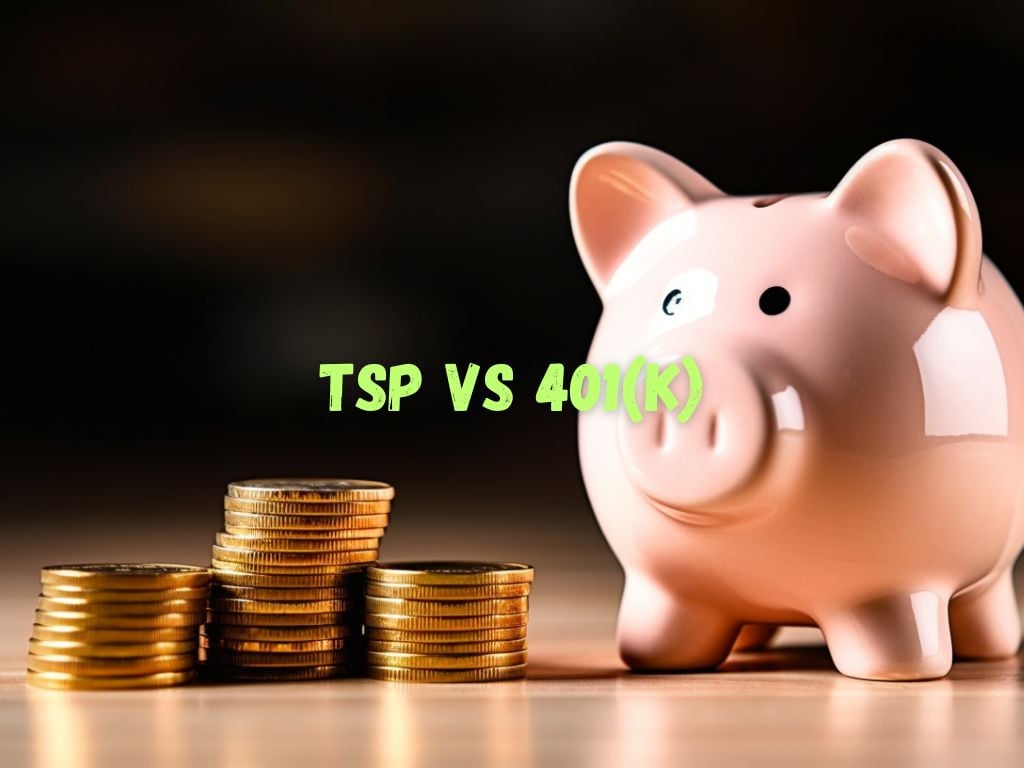When it comes to planning for retirement, two popular options that often come up are the Thrift Savings Plan (TSP) and the 401(k) Plan.
Both plans offer individuals the opportunity to save for their golden years, but understanding the differences between them is crucial in making the right choice.
In this article, we will explore the key aspects and look at the TSP vs 401(k) plans comparison and help you decide which plan suits your needs best.
Overview of Thrift Savings Plan (TSP):
The Thrift Savings Plan (TSP) is a retirement savings plan designed specifically for federal employees and members of the uniformed services.
With TSP, participants have access to a range of investment options, such as the G Fund, F Fund, C Fund, S Fund, and I Fund.
These funds allow TSP account holders to diversify their investments and manage risk effectively.
Additionally, contributing to TSP provides individuals with certain tax advantages and the potential for employer matching contributions.

Overview of 401(k) Plan:
On the other hand, the 401(k) Plan is a retirement savings plan typically offered by private sector employers.
Employees contribute a portion of their pre-tax salary to their 401(k) account, and in some cases, employers may match a percentage of these contributions.
Similar to TSP, participants in 401(k) plans also have access to various investment options, allowing them to grow their retirement savings over time.
TSP vs 401(k): Differences
Eligibility Criteria:
The Thrift Savings Plan (TSP) is available exclusively to federal employees, including civilian employees of the federal government and members of the uniformed services like the military, Coast Guard, and Public Health Service.
This means that if you’re not a federal employee or a uniformed service member, you can’t participate in the TSP.
In contrast, 401(k) plans are available to employees in the private sector. Whether you work for a small business or a large corporation, if your employer offers a 401(k) plan, you can participate in it.
This broader eligibility pool makes 401(k) plans accessible to a larger portion of the workforce than TSP.
Contribution Limits:
TSP and 401(k) plans have different contribution limits.
As of 2023, the maximum annual contribution for TSP is $19,500, with an additional $6,500 allowed as catch-up contributions for individuals aged 50 or older.
In contrast, the maximum annual contribution for a 401(k) account is also $19,500, but the catch-up contribution limit is higher, at $6,500.
Investment Options:
While both TSP and 401(k) plans offer investment options, the range can vary.
TSP primarily provides participants with funds that track specific sectors, such as the G Fund (government securities), F Fund (fixed income index), C Fund (common stock index), S Fund (small-cap stock index), and I Fund (international stock index).
401(k) plans typically offer a broader selection of investment options, including mutual funds, stocks, bonds, and exchange-traded funds (ETFs).
It’s important to note that TSP is known for its simplicity and low fees.
The funds offered within TSP have negotiated low-cost expense ratios, which can help participants maximize their returns over the long term.
On the other hand, 401(k) plans may have higher expense ratios depending on the chosen investment options and the management fees charged by the plan provider.
It’s essential to carefully consider the investment options and associated fees when selecting a retirement plan.
Fees:
When it comes to fees, TSP generally has lower expense ratios compared to most 401(k) plans.
The Federal Retirement Thrift Investment Board (FRTIB), which oversees TSP, has negotiated low-cost expense ratios for the funds offered within the plan.
401(k) plans, however, may have higher expense ratios depending on the chosen investment options and the management fees charged by the plan provider.
Employer Matching Contributions:
The Thrift Savings Plan offers participants the potential for employer matching contributions.
This means that if you contribute a certain percentage of your salary to your TSP account, your employer may match a portion of that contribution, effectively giving you free money towards your retirement savings.
The specific matching formula varies depending on your employment agency or service branch.
Similarly, many 401(k) plans also offer employer matching contributions.
The matching formula will differ from company to company, but it generally involves an employer matching a percentage of an employee’s contribution, up to a specified limit.
Employer matching contributions are a significant advantage as they provide a substantial boost to retirement savings, helping your money grow faster over time.

Taxation:
When comparing the taxation aspects of the Thrift Savings Plan (TSP) and 401(k) plans, it is important to consider how contributions and withdrawals are treated for tax purposes.
Both plans offer pre-tax contributions, meaning that contributions are deducted from an employee’s income before taxes are applied.
This reduces the taxable income, potentially lowering the overall tax liability for the year.
In the case of the TSP, contributions and any earnings within the plan are tax-deferred until withdrawal.
This allows for tax-free growth of the investment until retirement. However, when funds are withdrawn from the TSP, they are subject to federal income tax.
It’s important to note that if withdrawals are taken before the age of 59½, they may also be subject to a 10% early withdrawal penalty in addition to the regular income tax.
This penalty is designed to discourage early withdrawals and encourage long-term retirement savings.
Similarly, contributions to a traditional 401(k) plan are made on a pre-tax basis, reducing an employee’s taxable income for the year.
Like the TSP, taxes on both contributions and investment gains in a 401(k) plan are deferred until withdrawal. At the time of retirement, when funds are withdrawn, they are subject to federal income tax.
Early withdrawals from a 401(k) plan before the age of 59½ may also incur a 10% early withdrawal penalty in addition to regular income tax.
It is worth mentioning that tax treatment for Roth 401(k) plans is slightly different. Contributions to a Roth 401(k) are made on an after-tax basis, meaning that they are not tax-deductible in the year they are made.
However, qualified withdrawals from a Roth 401(k), including both contributions and earnings, are tax-free.
Roth 401(k) plans may be offered as an option by some employers, allowing employees to weigh the benefits of tax-free growth against the benefits of pre-tax contributions and potential tax savings at the time of contribution.
Understanding the taxation aspects of both TSP and 401(k) plans is important in making an informed decision.
It’s advisable to consult with a financial advisor or tax professional to assess your specific tax situation and determine which plan aligns best with your retirement goals and tax strategy.
Pros and Cons of TSP:
Pros:
- Accessible to federal employees and uniformed services members.
- Offers low-cost investment options with negotiated low expense ratios.
- Provides potential for employer matching contributions.
- Comes with certain tax advantages, such as tax-deferred growth and the potential for tax-free withdrawals during retirement.
- Allows for automatic payroll deductions, making saving for retirement more convenient.
Cons:
- Limited investment options compared to 401(k) plans.
- Restricted to individuals working in the federal government or uniformed services.
- Withdrawals made before the age of 59½ may be subject to additional penalties.
Pros and Cons of 401(k):
Pros:
- Available to individuals working in the private sector.
- Offers a wider range of investment options, including mutual funds, stocks, bonds, and ETFs.
- May provide more flexibility in terms of contribution limits, as some employers may allow employees to contribute higher amounts to their 401(k) plans.
- Allows for employer matching contributions, which can significantly boost retirement savings.
- Offers portability if switching employers, allowing individuals to roll over their 401(k) funds into a new employer’s plan or an individual retirement account (IRA).
Cons:
- May have higher fees compared to TSP, depending on the plan provider and investment options chosen.
- Not accessible to federal employees and uniformed services members.
- Withdrawals made before the age of 59½ may be subject to taxes and additional penalties.
TSP vs 401(k): Which is Better?
Choosing between TSP and 401(k) depends on various factors, including your employment status and personal financial goals.
If you are a federal employee or a member of the uniformed services, TSP offers a convenient and low-cost option with potential employer matching contributions.
On the other hand, if you work for a private sector employer, a 401(k) plan provides a broader range of investment options and greater flexibility.
It’s crucial to evaluate your individual circumstances and consult with a financial advisor before making a decision.

Frequently Asked Questions:
Can I contribute to both TSP and 401(k) simultaneously?
Yes, it is possible to contribute to both TSP and 401(k) plans if you are eligible for both. However, it’s important to consider your overall retirement savings goals, contribution limits, and investment options.
Can I roll over my TSP into a 401(k) or vice versa?
While rolling over funds from a TSP to a 401(k) is generally not allowed, you may be able to roll over funds from a 401(k) into a TSP if you become a federal employee or a member of the uniformed services.
Are TSP and 401(k) plans protected from bankruptcy or creditors?
In general, both TSP and 401(k) plans offer some degree of protection from bankruptcy or creditors.
However, there may be certain exceptions and limitations depending on your specific circumstances, so it’s advisable to consult with a financial advisor or legal professional for personalized guidance.
Conclusion:
Planning for retirement is an essential aspect of securing a financially stable future.
The TSP and 401(k) plans provide individuals with valuable tools to save for their retirement years.
By understanding the differences of TSP vs 401(k) plans, you can make an informed decision that aligns with your specific needs and goals.
Remember to consider eligibility criteria, contribution limits, investment options, fees, and employer matching contributions before selecting the plan that best suits you.


 Tags:
Tags:










